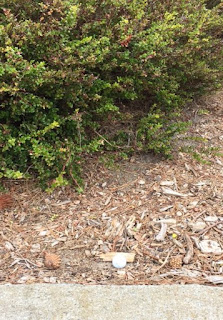The course features one of the busiest intersections I've ever seen. The sixth, thirteenth, and fifteenth holes run parallel to each other, six and thirteen going one way, fifteen the other. I wrote about it after last year's event, which you can read about here.
There's never a dull moment here. This year, I had four separate requests for relief. The answer in each case was no. Here's a brief rundown, with the explanations. In all cases the pictures are re-creations of the situation, taken after the fact.
This player's ball was in the thirteenth fairway. He was playing the fifteenth. You can see the green in the distance. There is a distance marker about a foot behind his ball.
I was stationed nearby, and heard the player tell his fellow competitors that he was going to take relief from the disk. I approached him and asked what he was thinking. He told me the disk interfered with his swing. He said he was afraid he would hit it on his downswing. (Really? A guy playing division one golf?) Another official nearby joined in the discussion. We told him there was no such thing as "mental interference" and he must play it as it lies, unless he preferred to take an unplayable lie. Decision 24-2a/1, "Mental Interference by Obstruction," deals pretty clearly with this situation.
This ball is in the rough left of the thirteenth fairway. As you can see, there is a sprinkler control box, also in the rough, more or less on the player's line of play.
The player's coach called me over and asked if his player got relief. I informed him that unless the obstruction interfered with the player's stance or swing (Rule 24-2a), the answer was no. The coach made the argument that since the box was so close (less than ten yards) from the fairway, there should be a local rule allowing for relief. I told him that I would get another opinion if he wished, or his player could play another ball under 3-3, but my answer was no relief. He dropped the issue and the player played on.
A bit later, I found Decision 33-8/17, which states that the committee is not allowed to adopt such a Local Rule, since it is not unusual to find irrigation control boxes on golf courses. Bingo! A word for word explanation! I showed it to the coach later in the day. His smile told me that he probably already knew that, and was just trying to help his player. Looking back, I'm sure he did. He's been in golf all his life, and his brother is a multiple major championship winner...
The ball below was in lateral water hazard to the right of the sixteenth fairway, on the edge of the bridge which crosses it.
The player asked if he was entitled to relief from an obstruction. Nope. Rule 24-2, Note 1: "If a ball is in a water hazard, the player may not take relief from interference by an immovable obstruction. The player must play the ball as it lies or proceed under Rule 26-1."
Since not only was the bridge in the player's swing path, but the ball was also sitting in a depression, he took relief outside the hazard. In fact, he took what is surely the least known option: He went to the other side of the lateral hazard (to the right), to a point equidistant to the hole as the entry point of his original shot, and proceeded from there, since it offered both a cleaner lie and better angle to the green. This point is a lot easier to ascertain now that the NCAA allows the use of laser range finders!
Finally... This player's ball was a few paces off the putting green, with a couple of sprinkler heads in his line of play.
He asked for relief so he could putt. Tournaments often adopt a Local Rule allowing for relief if the the obstruction is within two club lengths of the green, and the ball is within two club lengths of the obstruction--the "Two and Two" Rule. In this case, the committee had decided not to adopt this, as was noted in the rules sheet each player received. So, again, no relief!
Interesting day. One day, four denials of relief. Best advice: Play Hard!







